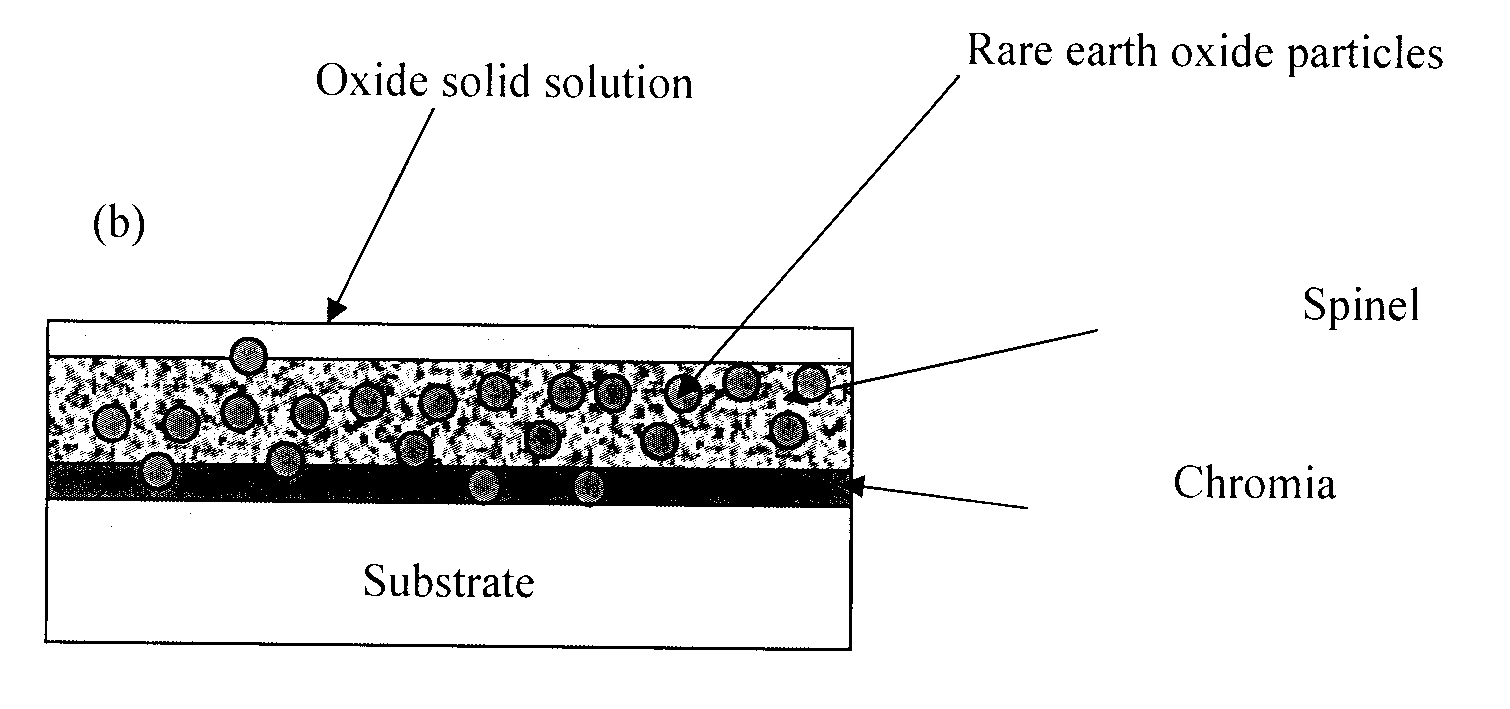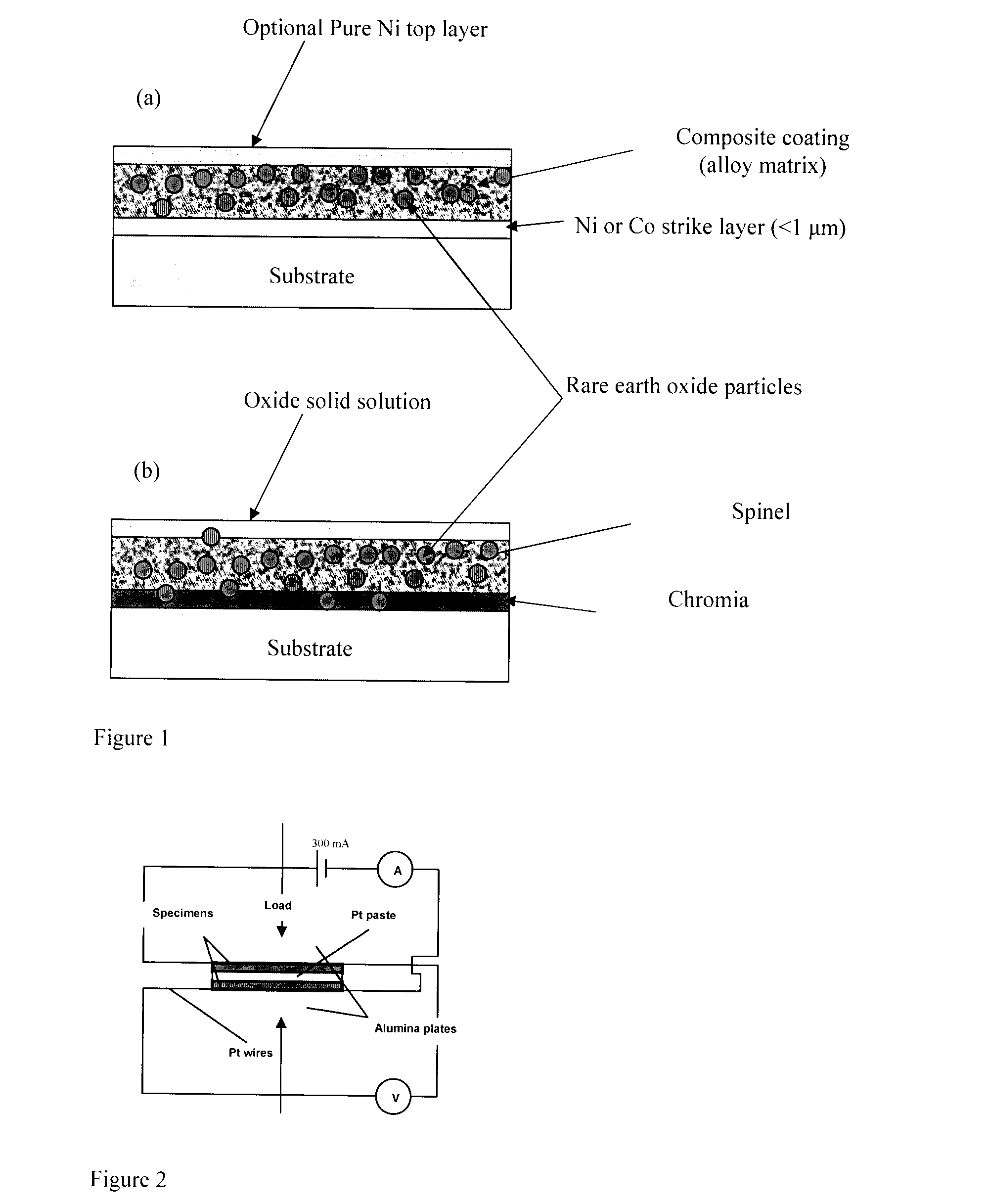Composite coatings for oxidation protection
- Summary
- Abstract
- Description
- Claims
- Application Information
AI Technical Summary
Benefits of technology
Problems solved by technology
Method used
Image
Examples
example 1
[0048]FIG. 1 represents a schematic drawing of as deposited coating (FIG. 1a) and of oxidized coating (FIG. 1b) with corresponding different layers. Haynes® 230®, Ni-based superalloy the composition of which is listed in Table I, was selected as the cathode substrate. The coating comprises Ni and Co alloy (50% Co) and gadolinia doped ceria, (CeO2)0.9—(Gd2O3)0.3(GDC) particles (d10=0.4 μm, d50=0.5 μm, d95=1 μm). Electroplating was used for deposition of the composite coating. The planar anode and cathode substrate were placed horizontally in the plating bath. The composition and operating conditions of bath used for composite electrodeposition are listed in Table II.
TABLE Idescribes the nominal compositions of Haynes ® 230 ® (wt %)NiCrWMoFeCoMnSiAlCLaB5722142350.50.40.30.10.020.015
[0049]The cathode substrate is formed from a 2 mm thick Haynes® 230® sheet, cut into 20×20 mm coupons. The coupons were ground by grit 600 abrasive paper and cleaned ultrasonically in an alkaline cleaning s...
example 2
[0062]The procedure described in Example 1 was used to coat ZMG232L, ferritic stainless steel (Hitachi product). The coating composition is also the same as in Example 1. The composition for ZMG232L is listed in Table IV. The measurement and characterization techniques were identical to Example 1. The oxidation weight gain profiles in FIG. 15 show significant reduction in oxidation weight gain for NiCo / GDC composited coated specimens. The oxidation weight gain for coated specimens without GDC particles is much higher than even uncoated substrate. This indicates that rare earth metal oxide particles are indispensible constituent of the coating.
[0063]As seen in FIG. 16, the ASR values at different temperatures for NiCo / GDC (50% Co) coated ZMG232L® are well below the generally accepted criteria for SOFC interconnects that is 100 mΩcm2.
TABLE IVnominal composition (wt. %) of ZMG232L ® ferriticstainless steelFeCrCSiMnNiAlZrLaBal.220.020.080.460.340.050.190.05
example 3
[0064]Interconnect plates of Crofer® 22H (see Table V for composition) were coated using the same coating composition and technique described in Example 1. Short stack cell testing was performed for 800 hours at 700° C. and is intended to be continued for several thousand hours. The coated interconnect plates showed 0.1-0.2% / 1000 hours less degradation than uncoated plates. However, longer times are required to observe the full benefits of the coating since chromium poisoning effect requires several thousand of hours to appear.
TABLE Vnominal composition (wt %) of Crofer 22 H ® ferritic stainless steelFeCrCNSSiMnAlWTiLaPCuBal.20-240.03 max0.03 max0.006 max0.1-0.60.3-0.80.1 max1-30.02-0.20.04-0.20.05 max0.5 max
PUM
| Property | Measurement | Unit |
|---|---|---|
| Temperature | aaaaa | aaaaa |
| Length | aaaaa | aaaaa |
| Length | aaaaa | aaaaa |
Abstract
Description
Claims
Application Information
 Login to View More
Login to View More - R&D
- Intellectual Property
- Life Sciences
- Materials
- Tech Scout
- Unparalleled Data Quality
- Higher Quality Content
- 60% Fewer Hallucinations
Browse by: Latest US Patents, China's latest patents, Technical Efficacy Thesaurus, Application Domain, Technology Topic, Popular Technical Reports.
© 2025 PatSnap. All rights reserved.Legal|Privacy policy|Modern Slavery Act Transparency Statement|Sitemap|About US| Contact US: help@patsnap.com



